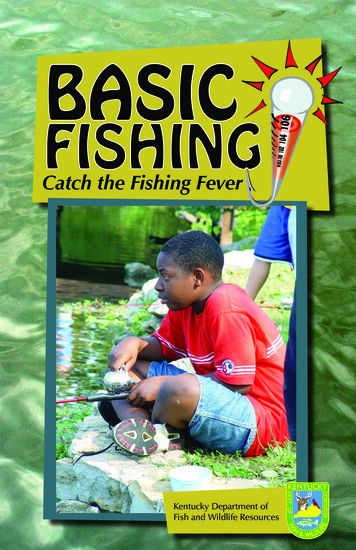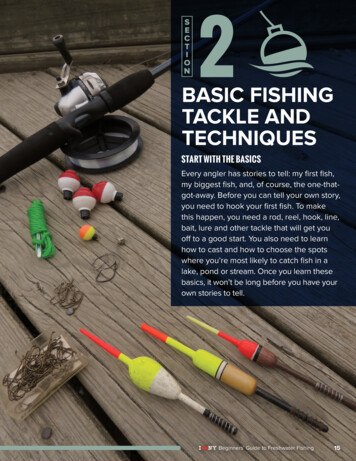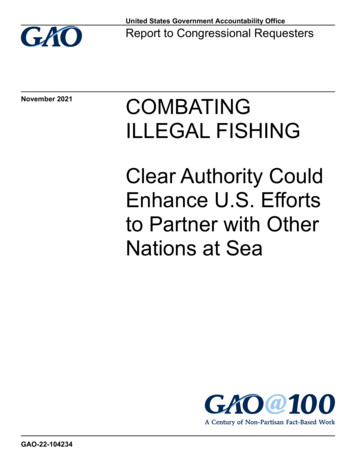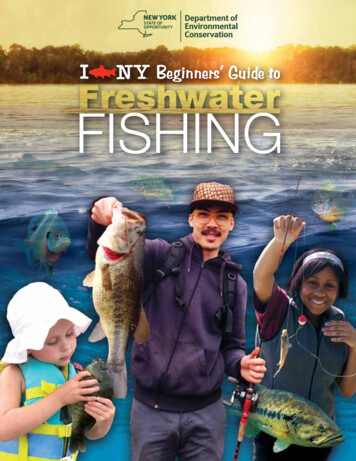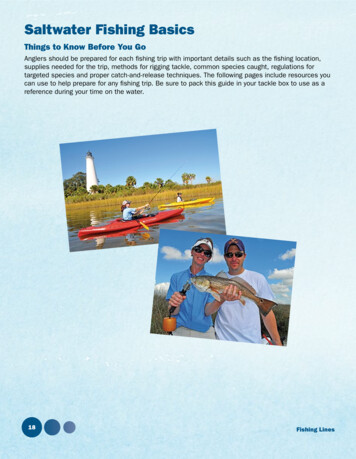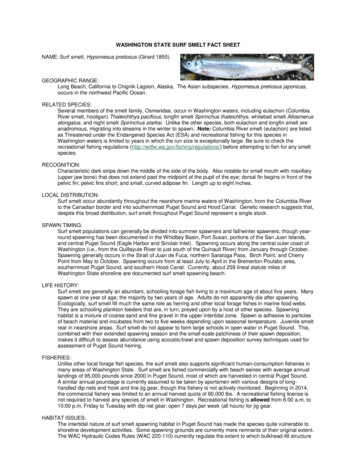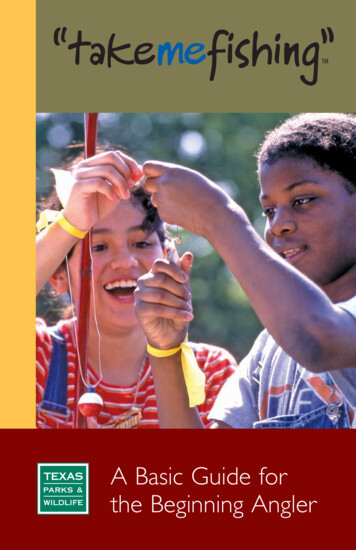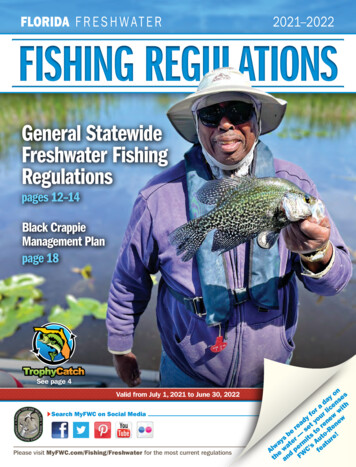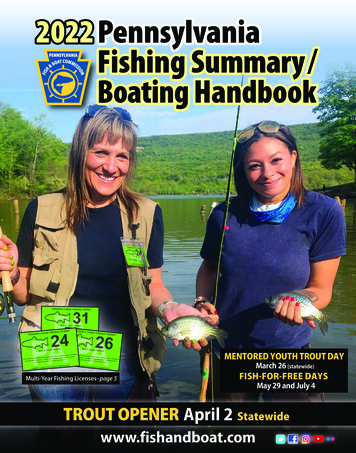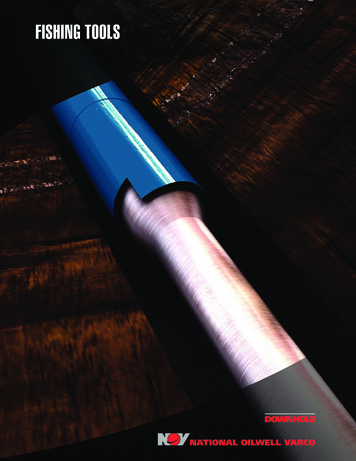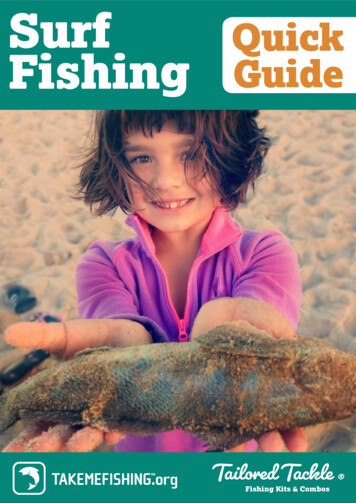
Transcription
SurfFishingQuickGuideFishing Kits & Combos
vLicense & RegistrationOne of the most important items any angler needs before they go fishing istheir fishing license. Each state has their own regulations and offers daily,short-term, or annual licenses. TakeMeFishing.org has a great tool to findout where to buy a fishing license, the types of fishing licenses available,age requirements, fishing regulations and online purchasing.1Click the button belowGET YOUR FISHING LICENSE2Select your stateReview the best licens3 ing options to fit yourfishing needsYour state’s profile has links to resources where you can review the statefishing regulations and browse different types of fishing licenses availablein your area. Many states allow you to purchase your license online andprint out a temporary license to go fishing the same day. Remember to review the age requirements as children, seniors and veterans often receivediscounts and unique opportunities for open fishing.1
Places to Boat & FishReady to get out on the water but not sure where to start?Click the VIEW MAP below to find Places to Fish and Boat across the United States.PLACES TO BOAT ANDFISH NEARBYType in your Townor City into theSearch BarVIEW MAPBody of Water to fish and boat onBest Place to Fish and Boat withfamily-friendly amenitiesBoat Ramp to launch your boatMarinas, moorings and suppliesBait Shop to buy fishing bait & luresFishing License VendorsCharter & Boat rentalsFishing Gear & equipment vendorsUse this list of Key Symbols on themap to find places to fish, bait shops,and hot fishing bites!Click on a blue Body of Water icon on afishing spot near you to: Review Logged CatchesView Photos of Fish CaughtFilter Fish Species in the AreaRead Fishing ForecastsGet Directions to that LocationFly Fishing shops.Fish Refuge or Hatchery FacilityMultiple Places of InterestLoggedCatchesFishSpeciesFishingForecasts2
Fish Finder RigTACKLE Pyramid Sinker - 3-4 ozSinker Slider - XL8 mm Bead36” Leader - 40lbCircle Hook - 5/0GULFDrumSnookSharkMulletS. MulletAll Cut BaitEASTBaitStrip. ll Cut BaitWESTCOASTSpeciesStrip. Bass ShadLing Cod Lg. SquidSharkAll Cut BaitDrumMullet/BunkerTECHNIQUEYour big fish go-to! Load this up with any type of cutbait and cast it as far as you can. Keep the line taut andplace it in a beach spike as you wait for a big hit. Let thefish peel your drag a bit before setting the hook hard.3
Fish Finder Float RigTACKLE Pyramid Sinker - 3-4 ozThree Way Swivel - #3Dualock Snap - #418” Leader - 40lb2” Peg FloatJ-Hook - 3/0GULFSharkDrumTriple TailEASTSharkAll Cut BaitStrip. Bass BunkerDrumMulletWESTCOASTSpeciess BaitSharkAll Cut BaitStrip. Bass ShadLingcodLg. SquidSmall SharkAll Cut BaitMulletLadyfishAll CutbaitTECHNIQUEKeeping the pests away for mid-sized fish, adding a floatkeeps your bait elevated. Great for jetties and piers that getyou out further. Otherwise, cast past the second break. Thisis a great evening shark rig as it keeps away from the rays.4
Pompano RigTACKLE *PRE-MADE*Pyramid Sinker - 1 oz24” Mono Leader - 25 lbsWide Gap Hook - #4TECHNIQUEOn the beach, fish high tide rightwhere the swell meets the shore.Works great on piers, jetties andinlets if these conditions are notavailable. Make sure there is moving water, react quickly to bites.COASTSpecies5LFUGSTAETESWBaitPompanoSquid StripCroakerBlood WormSurf Perch Squid StripPompanoSquid Strip
Bottom Rig (Old Dominion)TACKLE Bottom Rig 18” - 40 lbEgg Sinker - 2 ozTie 2x Mono Leaders 6”2x Wide Gap Hooks - #4GULFSea TroutCroakerEASTBaitWeakfishCroakerFlukeS. BluefishWESTCOASTSpeciesSurf Perch Ghost ShrimpCroakerBlood WormSquid ShrimpRockfishShrimpSquid StripSheepshead Sand FleasBlood WormSquid StripSquid StripClamWeakfish BloodwormTECHNIQUEGreat for rocky bottoms or turbulent surf, use this heavier rigto catch smaller surf species on the beach, piers, jetties and inlets. Cast over the first break in the surf or keep close to pylonsand rocks when fishing platforms. Keep line taut and monitorsmall bites as the direct weight leaves no give for small fish.6
Ready Rig (Small)TACKLE *PRE-MADE*1 oz Egg Sinker24” Leader - 40 lbWide Gap Hook - #4COASTWEST EAST GULFSpeciesBaitSea TroutCroakerSnookShrimpSquid StripShrimpWeakfishCroakerFlukeBlood WormClamSquid StripSurf Perch Ghost ShrimpBlood WormCroakerRock Fish Sand CrabSurf PerchSquid StripTECHNIQUESmaller fish at low tide. Fish the first trough, or the nearestdrop in depth, typically 2-3 ft. Keep line taught and monitor for rapid taps. Can be fished on lighter freshwater gear.7
Ready Rig (Large)TACKLE *PRE-MADE*2 oz Egg Sinker24” Steel Leader - 40 lbJ Hook - 2/0GULFSnookSea TroutCroakerShrimpShrimpSquid StripEASTBaitWeakfishCroakerFlukeBlood WormClamSquid StripWESTCOASTSpeciesSurf Perch Ghost ShrimpBlood WormCroakerRock Fish Sand CrabSnookShrimpTECHNIQUESmaller fish at high tide. Fish the first trough, or the nearest dropin depth, typically 3-5 ft. Keep line taught and monitor for rapidtaps. Extra weight lets you cast over the first breakers and fish2nd trough.8
Saltwater LuresSaltwater lures are an advanced presentation used to target game fish andsort through smaller, less appealing species. Use lures when water clarityis high and surf conditions are moderate as they incite visual strikes. Refrain from the use of lures unless schools of bait-fish are prevalent or thetarget species is actively feeding.Silver SpoonWade into the first trough or stand onthe first sand bar and cast the silverspoon laterally, in parallel with theshoreline. Steadily retrieve to reflectlight in high clarity water. Tip the hookwith the tail of a grub so fish target thehook-end upon striking.Grub & JigCast into the second trough andbounce along the bottom coveringall transitions through both troughs& sandbar. Pause often, allowingthe fish to pick the grub up off thesea floor. Pitching a grub in movingwater along jetties, passes and inlets isproductive.Topwater Popper9Great for large swellswith big pauses andstrong water clarityas found on the East &West coast. Walk this lure like a dogon the top of the water through thesuds left after a crashing wave. Lookfor seams or cut-off points where thelength of a crashed wave expands andgives you more surface to cover.
Essential ToolsThe Tailored TackleSurf Fishing Kit sportsall the surf fishing rigsand lures from theQuick Guide.Bolt CuttersFillet KnifeTowelSand SpikeFishing PliersSaltwater ToolsHeading to the beach with the correct assortment of saltwater fishingtools is critical. The most important tool to bring along is a 6” to 9” filletknife to cut your frozen bait. To remove hooks from toothy fish like shark,bring a pair of 6” to 12” fishing pliers. We recommend investing in plierswith a line cutter, crimper, and wire cutter, like the 6.5” pliers from ourFreshwater Kit. These features help fix and maintain your surf rigs. boltcutters are handy when handling hark and removing swallowed hooks onwire rigs. Lastly, bring along a towel to wipe off salt & scales.Sand Spikes hold your rod for convenienceand are essential for fishing multiple rods10
Frozen BaitFrozen bait is the most convenient andaccessible bait type for surf fishing.While fresh bait caught with a cast net is ideal, frozen bait works just fine.The frozen bait we discuss is the most common assortment of Gulf Coastbait, simply convert the size of bait we discuss to the local bait available. Forexample, the methods on cutting and baiting mullet can be used for bait fishlike bunker on the East Coast and shad on the West Coast. Shrimp and squidare universal and the most popular staple across all US coasts.Cut MulletSquidFingerMulletShrimpLive BaitLive bait like pinfish is a greatoption on the beach if your baitshop sells them or you can castnet. Make sure to store them ina cooler and supply them withoxygen through an aerator.Don’t weight live bait with rigsor they will turn into dead bait.Either free-line them with abare hook or drift them un11 der a float for best results.Pinfish
How To Bait Squid1234512
How To Bait ShrimpFrozen Bait StyleLive Bait StyleHow To Bait Sm Cut Bait131234
How To Bait Lrg Cut Bait1234567814
Surf Rod & ReelThe most importantSURF REELfactor in selecting theappropriate surf fishing reel is theamount of line it can spool. At minimum, you need a reel that can hold500 yds of 25 lb Braid. Many of thespecies you target will grow over 3 ftin length. Anything that large can peeloff at-least 250 yds of line. A mid-levelreel in the 6000-8000 size range willsatisfy these requirements.Size: 6000 - 8000SURF ROD 8 - 10 FTYour rod needs enough height so the lineclears the surf breaking near shore when it istaut. 8 ft will work in the Gulf, but 10 ft is theminimum for the East & West Coast. A medium-heavy power rating with a 2-6 oz lure rating is needed to cast 4 oz sinkers and handlefish over 3 ft. Unlike a fast action freshwaterrod, you want a moderate action surf rod tomaximize casting distance as bites are heavier and easier to indicate.LINE 25 - 50 LB BRAID15Braid is the preferred line type for surf fishing.You need as much line as your spool will take,and the smaller diameter of Braid maximizescapacity. If targeting game fish 3 ft or less,spool up 500 yds of 25 lb test. For anythinglarger, 500 yds of 50 lb braid is the minimum.
Surf CastingStarting Position: Walk into the waterto maximize your casting distance.Cast from ankle depth if targeting the1st trough or break. Proceed to casting from waist-high in order to reacha deeper section like the 2nd trough.11. Hold the reel’s shaft in-betweenyour middle and index finger. Pull theline against the rod handle with yourindex finger and open the bail (metalhalf circle) with your opposite hand.2. Gradually bring your rod over yourshoulder, keeping an eye on your rigto make sure nothing is tangled.23. In an long, steady, arching motion,swing your rod over your shoulder afull 180 degrees in front of you.4. Release your index finger at theapex of your cast.5. After your cast is complete, keepthe bail open and pinch the line withyour thumb and index finger. Walkslowly back, gradually releasing linethrough your fingers while keeping ittaut so that the line doesn’t catch inthe waves. Close the bail and place ina sand spike.53416
Reading the BeachSandbarA Sandbar is an underwater structure that causes incoming waves to break. During low-tide, sand builds up asnew shoreline farther from the beach. During high tide, much of the sandbuild-up remains, creating an underwater “bar” where incoming wavesbreak before they reach the new shoreline. Waves capping and rolling over,typically 20-30 yds out, will indicate the bar’s location. You will rarely targetfish on a sandbar. Instead, you will use the sandbar as a reference point to locate the deeper channel that forms between the Sandbar and shore, as wellas subsequent channels and drop offs beyond the 1st sandbar.A trough is a deeper channel that forms between the shoreline and the sandbar (1st trough), as well as subsequentchannels that may form between two sandbars (2nd trough). Troughs aremost often found in the first 10-20 yds between the shoreline and the firstsandbar. Trough’s are your primary location to target fish as they corralschools of bait-fish and act as a highway for all species. The larger predator fish cruise through troughs and attempt to ambush prey near entryways(seams) and cut offs (points). Target game fish under 3 ft in the 1st trough andlarger predators 20-30 yds past the sandbar.TroughSeamA seam is a separation between sandbars that causes water to flow into and out of the trough. Seams are one of thefew entryways into the troughs, and the moving water sucks in and pushesout bait fish. Target the pools on the side of the inflow/outflow as predatorsstage here to ambush prey. A seam typically sports the largest number fishanywhere on the beach as it condenses traffic too and from the trough.PointA point is a shallow area of the beach that juts out and gradually declines in depth at a much lower rate than the rest ofthe beach. Points close off a trough and naturally form deeper pools on either side. Bait fish pile up in confusion when the trough hits a point and theyneed to turn around. Larger predator fish wait in ambush. Target the sides ofpoints where deeper pools form but do not target the point itself.CoverUnlike freshwater fishing, cover that provides shade and protection is rare and challenging to find on the beach. Walk thebeach and look for changes in the on-shore make up like rocks and jetties.Often times changes in the beach are reflected underwater. Low tide is agreat time to identify these constructs. On high clarity days, you can identify cover by spotting pockets and lines within the water that maintain a17 darker color.
Beach StructureSandbar #2Trough #2Sandbar #1Trough #1SEAMTrough #2SandbarTrough #1POINTSteady DeclineSandbarTroughMapping StructureThe most effective method for identifying the structure of the surf is to watch the waves and locate where theybreak. If a sandbar is prominent, the surf will break at the apex of the bar,leaving a wash of suds over the trough. If multiple bars are in place, waveswill reform and break again at a smaller scale as they near shore. Seamscan be identified by a gap in the line of wave breaks, and are most prominent when the divergent waves break in opposite directions. Confirm thesignificance and depth of each structural feature by walking in a straightline out into the water until you reach chest height. This method typicallyworks for troughs, sandbars and points. App based mapping like theFishbrain app can give you a general sense of your beach’s structure. 18
2 Pole ApproachFishing with multiple rods on the beach improves your strike rate and allowsyou to effectively target multiple species at the same time. We recommendtwo poles per angler. Have one pole rigged up with a heavier rig and largercut bait and one pole sporting a smaller rig with shrimp or squid. Use thelarger rig to target larger species which often take longer wait times. Whilewaiting, you can actively fish for smaller species to harvest table fair or baitfor your heavy rigs.Fish are attracted by the scent of your bait and the activity generated bypitching lures and catching fish. Hitting the beach with more anglers tomanage more lines with more bait is recommended. Space out your spikes& rods roughly 5-10 yds apart to cover more water while still being able toreach a bite on time. Six poles total for two people is an efficient sweet spotfor getting on a bite. Consolidating to 4 rods is the most manageable way toeffectively bait and rig at a fast pace.19
Light Rig for Table FairUse light rigs with smaller bait near the shoreto target the most common and best eatingsurf species. In a two pole approach, your lighttackle will keep the day exciting as your heavyrigs average 1-2 hits per hour. Lighter tackleenables you to target snook, sea trout, croaker,small shark and more!Tie on a 1-2 oz ReadyRig or a Bottom Rig.Bait with squid strips or shrimp. Cast into the1st trough or the area between where the waves break and the shoreline. If thewaves are breaking at shore, fish right in the breaking surf when the waves areless than 3 ft. If waves are greater than 3 ft, target an area roughly 10-20 yds pastthe wave break.Setting UpHold your rod while fishing light tackle as the bites are subtle. You should feel a tap-tap when the bite starts. Wait until there are 3-4 repeated taps or a hard tug before settingthe hook. If you don’t get a hit in 5-10 minutes, check your bait, move over 10-20yds, and cast again. If you received light taps without commitment from the fish,reduce the size of your bait. When smaller fish become a pester, increase the sizeof your bait to filter them out, but know that the number of bites will reduce.The Bite!The Fight!Keep your drag loose but also tight enough to set thehook on a smaller bite. After a series of taps or a strongertug, set the hook by raising your rod tip roughly a foot. Keep your line taught andconsistently retrieve so there is no slack in your line. If it is a sizable fish, let the fishpull drag. If the fish runs left or right, walk with it and maintain a taut connection.Releasing FishOnce the fish nears the shoreline, keep yourrod tip high and gradually drag it to theedge of the water. Set your rod into a sandspike and bring a pliers over to remove thehook. Lift the leader of your rig with onehand and remove the hook with the pliers inyour other hand while the fish is beached.Handle the fish with wet hands and avoidgripping the mouth until you can identifytooth sharpness by species. Walk intothe water and submerge fish to release. 20
Heavy Rig for Big FishUse heavy rigs with bigger bait to target fish over 3 ftsuch as shark, stripped bass and bull sized red drum.A good heavy set up is the fish finder rig sporting a4 oz sinker and baited with a 2” wide cut of mullet. If junk species like sea catsor crustaceans pick away at your big bait, add a 2” foam float to your leader afew inches away from the hook. While adding the extra float will likely reducestrikes, your bait will be lifted away from pests and available for a larger predator. Sharks don’t seem to mind a little extra hardware. The larger species roamthe depths on the other side of the sandbar since feeding in the trough requirestoo much energy. At their size, deeper water more adequately conceals predators from their prey.Rigging UpCasting OutYou typically want to get heavy rigs out as far as possible. Wade onto the sandbar and make your cast atwaist deep so you can clear the surf. Keep your bail open and slowly feed outline as you walk back to shore to prevent the waves from carrying your slackline and moving your bait. Once back at shore, set your rod into a sand spikeand reel in until the line is taut to your weight. Dropping your bait with a kayakor paddle-board is an effective way to get your rigs out deeper.Drag SettingTurn your dragdown fairly loose,so it is light enough to pull line out withoutremoving the rod from the sand spike. Whenlarger fish hit, they peel very hard and veryfast. Your entire rod will bend over and if thedrag is too tight your line will snap or the fishwill drag your entire set up into the ocean.Watch your rod and lisThe Bite! ten for peeling drag.Check your bait everyhalf hour and change your bait every hour toconsistently provide fresh scent. Do not worry about light taps on the rod tip. Your rodwill always display a lighter show of bendingand tapping because of the waves and current. You will know when there is a fish on, asthe rod will bend halfway over and your linewill peel out. When this happens, you have afish on. Run over to your rod and ginger21 ly remove it from the rod spike.The Tailored Tackle Surf Fishing Kit has all the surf fishing lures and rigs to get outand land fish on the beach.
You want to let the fish make its initial run, solet it peel drag as you hold your rod and loosen the drag lightly if it pulls you forward at all.Once the running slows down, turn your drag up 1-2 turns so that you can set thehook and turn the fish around. Set the hook by lightly tugging upwards roughlya half a foot. After the fish turns, rapidly reel in slack until the fish puts pressureback on. If the fish takes another run after the turn, wait for the fish to slow downbefore trying to turn it again.Setting the HookMaintain a taut line withoutgiving any slack. When thefish runs, let it peel line andbe patient. When the run slows down, lift yourrod in a 90 degree arc from waist to eye levelwithout reeling. Lower your rod back down andreel rapidly to avoid any slack. During the fight,a large fish will abruptly run. If you are reelingin at the time of this run, your drag will tightenup and your line will snap. Pulling the fish in bygradually lifting up and then reeling in slack reduces break offs during the fight.The FightAt high tide, larger fish will often fight in the direction of a trough. Stay parallelwith the fish as you fight, walking the shoreline to maintain coherency. If a fishtakes off too far to your left our right, the angle will reduce your leverage andyour line will cut on rocks and shells at the shoreline or sandbar. Always stayparallel.Fighting a big fish from the shoreline at low tide will lead to a lost fish becauseyour line will chafe against the sandbar as the fish pulls deeper. Walk out andfight your fish on the second sandbar. Tides change fast and fights can last overan hour. At low tide there might be only 1 ft of water halfway between you and afish. You won’t be able to land the fish if you are not standing on the sandbar tomaintain leverage.Releasing FishLand larger fish with 2 people. Maintain tightslack until a second angler can grab the beginning of the leader and drag the fish nearshore. If you are by yourself, do your best toland the fish by beaching it in the shallowsand grabbing the leader with your other hand.Try not to drop your pole in the water assalt and sand are very corrosive to the reel.Place your rod in a sand spike while youremove the hook and release the fish. 22
Beach ConditionsWind speed and wave height drastically effect the presentation of your bait. High winds,typically greater than 15 MPH, put pressureon your line as it fights to stay taut with your rig. Your line will yew to the windpattern, making bite indication a challenge and drive your bait to shore. Strongwinds rev up wave speed and move your bait too fast. In high surf or windydays, default to fishing larger sinkers and baits. Lures are rarely an option inthese conditions. No winds and/or low surf are problematic also as your baitsscent covers a smaller radius and the food chain is less active as a whole. Theideal wind range is 5-10 MPH. Ideal wave heights range from 2-3 ft in the gulfand 3-5 ft on the coasts.Winds/ WavesWind speed and wave height often dictatewater clarity. While coastal regions vary, surffishing is generally more productive in higherclarity water relative to the region. Most game fish and table fare species relyon sight more dominantly than smell. High wind speeds create a choppy surfthat kicks up sand and fogs the water. Less appealing species like sting rays,sea cats, and other bottom feeders feed heavily in these conditions due totheir competitive advantages in scent predation. You will still have a fun daycatching shark, but a trophy snook or striped bass is less common. Extremelyclear water is a challenge on its own, as wave height is often too low to rev thefood chain and fish are more timid. A well rounded mix of decent water clarity,moderate wind speed, and average wave height generate the best surf fishingconditions.Water ClarityDay/NightDaytime is most conductive togame fish that depend on sight.However, some sport species likeShark are most active at nightwhen they prey on inactive schoolswith a keen sense of smell.Fishing dawn/dusk gives you access to the Shark bite as well asgame fish species. When fishingat night, get set up at dusk whenthere is light to avoid any riggingmistakes. Make sure to bring ahead lamp and reduce your timespent wading in the water.23
LEAVE THE BEACHWhen There Are:Signs of LightningHigh Surf AlertWinds over 20 MPHHazardous AlgaeTidal PatternsTides are the rising and falling of theocean’s sea level. An incoming tide brings in water and raises the sea level. Anoutgoing tide pushes out water and lowers the sea level. The moon’s gravitational pull of the Earth moves water. When a coastline is closer to the moon’spull, water flows in causing a high tide. When that coast line is further away,water flows out causing low tide.Tides are important for surf fishing because the flow of water moves the foodchain. Algae feeds on sun, bait fish feed on algae, game fish feed on bait, bigfish feed on game. The tides move the algae and everything else ncoming tide is often the best surf fishing as the food chain is getting pushedtowards you. The rise of sea level also brings nutrients in from the shore andgives fish new access to fertile feeding grounds. Outgoing tide is comparativelypoorer fishing, as the food chain is leaving you and fertile access is diminishing.However, moving water is the most important factor. When tides go slack atpeak high and bottom low, biology takes over and fish focus their energy ontransitioning their location and appetite. The 1-2 hours at peak low & high24tide are typically the slowest bite as fish are not actively feeding.
Rock Fish Shrimp Shrimp Squid Strip Blood Worm Clam Squid Strip Ghost Shrimp Blood Worm Sand Crab Snook Shrimp TECHNIQUE Smaller fish at high tide. Fish the first trough, or the nearest drop in depth, typically 3-5 ft. Keep line taught and monitor for rapid taps. Extra weight lets you cast over the first
